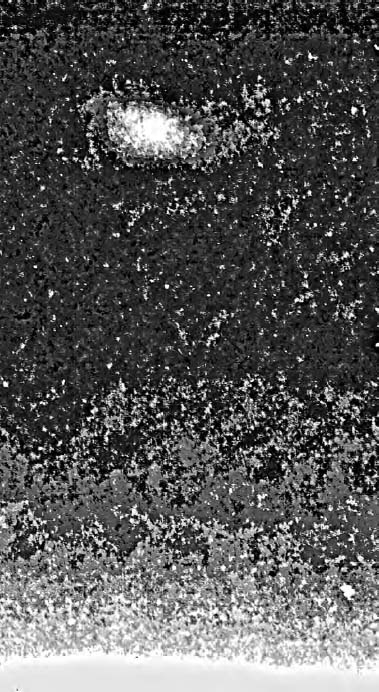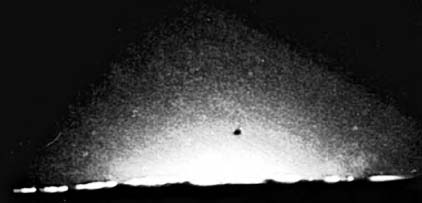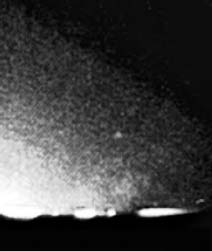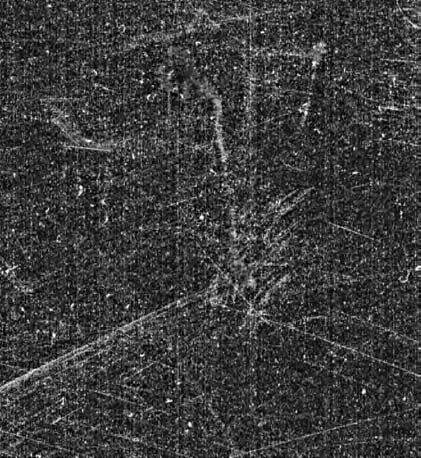Read Ancient Aliens on the Moon Online
Authors: Mike Bara
Ancient Aliens on the Moon (8 page)
The Tower (enhanced).

The Tower viewed from the side in Apollo image AS10-32-4856.
Not only is all this patently absurd within any current (or proposed) natural geologic model of the lunar surface, it totally supports the concept that the Tower/Shard are nothing but remaining fragments of a once far-larger, also clearly artificial structure. This structure, because of its transparent nature, was apparently once composed of something like glass, and, attached to some kind of darker, vertical structural framework.
After confirming the existence of the Tower from another photograph taken by the Apollo 10 mission, it became obvious that there was some kind of transparent, glass-like structure over large swaths of the Sinus Medii region. But how could such a structure survive on the lunar surface for so long? Isn’t it dangerous to build glass houses in places where people throw stones (like the Moon)?
That question is actually easy to answer: all materials, including glass-based minerals like quartz silica, take on different properties in the hard, cold vacuum of space than they do on Earth. One of the most abundant substances of this world is water; in liquid, gaseous or solid form. Space however, has an appalling lack of water, so much so that it can be easily stated that water is one of the least available resources in the vast expanse of emptiness we call space.
As it turns out, this is one of the qualities of the vacuum that makes glass not just a desirable, but an
ideal
material for building structures on an airless world like our Moon. Glass on Earth is well known to have little tensile strength, meaning it doesn’t stretch easily because it is brittle and will not withstand even a very weak impact from a hard object. When you throw a baseball at a glass window, it fractures and cracks easily and with little resistance. However, if you attempt to crush a glass sphere, you’ll find that it has a great deal of strength under compression stresses.
The reason for these properties on Earth is that it is pretty much impossible to extract the water from glass as it is forming. Water is all around us, even in the most arid deserts. It is in the ground as a liquid, frozen in the arctic as a solid, and even in the air around us as humidity. All this water causes a phenomenon called “hydrolytic weakening” when glass is being manufactured on Earth, meaning that at the molecular level, the bonding of silicates and oxygen is resultantly weakened. This produces a transparent, brittle and fragile material we call common glass. Manufactured under Earthly conditions, we have found that glass is a very useful and artistically pleasing medium for a variety of uses — but structural construction is not one of them.
In short, on Earth, we don’t build glass houses.
But the Moon is a completely different story. It is airless, with no humidity to interfere with the molecular bonding of the silicates that make-up the glass that is omnipresent. The hard-cold vacuum enhances the strength of lunar glass to the point that it is approximately twice as strong as steel under the same stress conditions. In fact, several papers from scientists at Harvard and other universities have suggested that lunar glass is the ideal substance from which to construct a domed lunar base.
1
All I’m proposing is that somebody else came up with the idea long before we did. “Somebody,” as in Ancient Aliens.
But if this concept is valid, then there must be other evidence to support it, right? As it turns out, there’s plenty.
Surveyor 6 was an unmanned NASA robot probe that successfully landed on the Moon in November 1967 about thirty miles west of “Bruce,” a small five-mile wide crater near the center of Sinus Medii. From there, the Surveyor spacecraft took over 35,000 images of the surrounding lunar landscape. One night after local sunset on November 24, an additional set of time-exposed images were acquired looking west, for purposes of studying light-scattering properties in interplanetary space caused by the solar corona, which was at the time far below the lunar horizon. These images, when they were released, caused something of a fire storm.

One of the Surveyor 6 images.
Instead of the Sun’s faint corona, the image contained a huge flare of light on the horizon, very similar to a common sunset here on the Earth. The problem with this lunar sunset was that it was anything but common. The Surveyor image, with its remarkably brilliant beads of light stretching along the western horizon and an intensely geometric structure of scattered light seen against the lunar sky above it, was taken over an hour after sunset.
On Earth, when we see the sun set, the sun in fact has already “set” (dropped below the visible horizon) several minutes before. But the atmosphere of the Earth bends the light coming from the sun, so the sun we are watching slowly disappear over the horizon is actually already several degrees below that horizon. This atmospheric interference is also the reason the sun tends to turn more orange and distort in shape as it sets.

Surveyor 6 image.
All of this is well and good, except for one problem; the Moon has no atmosphere. So when
Surveyor
took the image, all it should have seen was the faint wisps of the Sun’s descending corona. This was certainly what the scientists expected to see.

The NASA guys quickly tried to come up with an explanation, and they settled on the idea that electro-statically charged fields had somehow suspended particles of dust in the lunar sky and created the dramatic sunset effect. This theory was later discounted by lunar soil samples, but the NASA explanation has never been officially withdrawn.

Scaffolding on the Moon. Close-up of box like, semi-transparent structures miles above Sinus Medii. Note the 3D structure and depth, and the interlocking sections of supports and structure. (NASA frame AS10-32-4816).
Which left a major mystery; what could cause such intense illumination more than an hour after sunset? The only viable answer is that there must have been some sort of transparent, intervening medium at (and beyond) the horizon that bent the Sun’s light and created the dramatic sunset effect. That “intervening medium” is nothing less than our theorized glass dome over Sinus Medii.
In fact, close-ups of the sunset images revealed this much fainter, lattice-like structure arching far above those mysterious brilliant beads along the horizon. This fading light was scattered just the way an atmosphere would scatter it. Only this “atmosphere” had geometric structure.
These optical phenomena could only be caused by the remnants of some kind of ancient, nearly transparent, glass-like, highly geometric architecture still anchored in the lunar surface and extending literally miles above it. The interlocking, scaffoldlike structure revealed in the Surveyor 6 images is very similar to the miles-high Shard and Tower elsewhere in Sinus Medii, but much better preserved. What was all but beaten to a pulp in the area of the Shard and Tower is remarkably intact just over the horizon some 100 miles distant.
Later, a further confirmation of this Sinus Medii “dome” was found on a picture taken by the Apollo 10 crew, NASA frame AS 10-32-4816.
Fortunately, the location of the Sinus Medii “dome” was amenable to further research, as in searching the image archives it turned out that a great deal of it had been photographed on later missions, especially Apollo 10.
After it was clear that Apollo 10 had taken a ton of photographs of the area where Hoagland suspected an immense scaffold-like structure had been constructed, he and other researchers began to pour over the Apollo 10 photo catalogs in an effort to find further images of the “dome,” Ukert, and Sinus Medii in general.

As these photographic catalogs were analyzed, a strange pattern quickly emerged. A great many of the thumbnail images in the catalogs appear to be very dark or almost completely blacked out, as if the astronauts had taken most of the photos with the lens cap on. This would tend to discourage an investigator from ordering prints of these images, since getting them from the NASA archives is not exactly cheap. So of course, being the trusting type, what did they do?
They ordered the blacked out pictures of course.
When you actually see some of the prints, it becomes obvious not only that the pictures are perfectly good, but that NASA would have very good reasons to discourage anyone from taking a close look at them. Some of these Apollo 10 images are absolutely chock-full of the kinds of objects that confirm the Sinus Medii dome model. Foremost among these was Apollo 10 frame AS10-32-4822.

